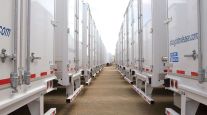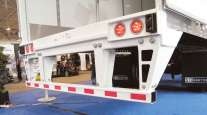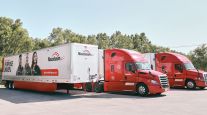Special to Transport Topics
Shaping the Future of Asset Management
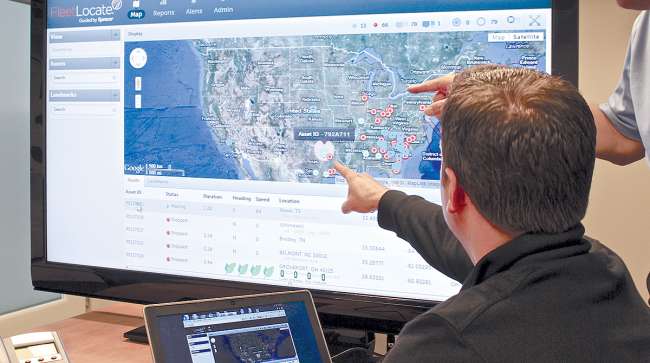
Technology adoption in the trucking industry typically focuses first on the back office and in the cab of the truck, but the proliferation of internet-connected devices and onboard sensors in recent years has increasingly pulled the trailer into the forefront of the conversation.
Although forms of trailer tracking have existed for many years, the latest advances in the Internet of Things and connected devices have greatly elevated the capabilities of these asset monitoring systems, which now offer a much broader range of information about the location and status of the trailer and the cargo inside.
Armed with that data, fleet managers have much greater visibility into their operations. The insights gained from these networks of tracking devices and onboard sensors can uncover new areas of opportunity for efficiency gains, and ultimately cost savings.
Better asset utilization is a key benefit of modern trailer-tracking technology, according to Aslan Motahedin, director of management information systems at XTL Transport, a refrigerated carrier based in Etobicoke, Ontario.
The carrier outfitted about 260 of its fleet of 1,200 trailers with the BlackBerry Radar tracking system for an initial pilot program and now intends to install the devices on its entire fleet.
The system enables the back office to take a close look at trailer activity.
“We’ve noticed that some trailers are being underutilized,” Motahedin said. “We like to keep our equipment moving. … If the trailer has been sitting for more than two days, we want to know that.”
In the past several years, carriers and technology vendors alike have recognized that incorporating technology works best when done through a holistic approach, mirroring the holistic approach to fleet management.
“It’s not just about the tractor, it’s about the driver, it’s about the freight, it’s about the total visibility … it’s the people out in the yards, on the dock. All those people can get value out of this overall solution,” said Chris Wolfe, president of asset tracking vendor I.D. Systems. “That’s how you improve the overall supply chain, [by] taking the holistic approach.”
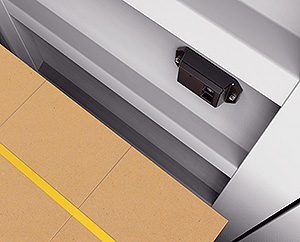
Onboard cargo sensors that monitor load status are becoming commonplace, technology vendors said. (BlackBerry)
I.D. Systems recently announced plans to acquire telematics firm Pointer Telocation for about $140 million and rebrand the combined company under the PowerFleet name.
The trucking industry’s use of trailer-tracking technology is expanding significantly, analysts said.
“Companies back in the day mainly focused on tracking the cab, but not necessarily the trailer,” said Bart De Muynck, a transportation researcher at Gartner. But recently, “we’ve seen better tracking … [and] that has increased the whole trailer-tracking market.”
Earlier iterations of trailer-tracking systems had to be hooked into the cab’s telematics and power system, but now they’re “going to mainly unfettered solutions,” De Muynck said. “They have their own power source, and you can track those trailers when they’re disconnected.”
That flexibility lets fleet managers keep tabs on trailers both on the road and in the yard.
Advances in technology have produced smaller, more durable and easier-to-install systems with more capabilities. They have longer battery lives than in the past, and many are now solar-powered. The combination of those factors has contributed to another reason more fleets are purchasing trailer trackers: The average price has come down.
In addition to trailer-tracking technology, cargo sensing solutions have taken off recently.
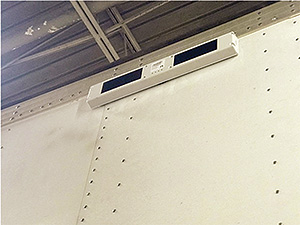
A solar-powered tracking system from SkyBitz installed on a trailer. (SkyBitz)
SkyBitz has offered cargo tracking options with its trailer systems for about 17 years, but during the first 10 years it offered cargo sensing, only about 8-10% of its customers utilized that capability.
“There wasn’t a lot of market adoption. But in the last three years, that has gone north of 70%,” SkyBitz President Henry Popplewell said.
Despite the recent growth, market penetration for trailer-tracking systems is still far lower than that of telematics systems for the tractor. One reason for that is compliance with government regulations, namely the federal electronic logging device mandate, which went into effect in December 2017.
In contrast, trailer tracking is “much more of a productivity play” right now instead of being driven by compliance, De Muynck said.
More Sensors, More Data
Many of the advances in trailer and cargo tracking come down to the expanded use and abilities of onboard sensors.
Early systems that emerged about two decades ago used a simple GPS tracker to display a trailer as a dot on a map. But as sensors have shrunk and grown more sophisticated, the systems have become more granular in what and how they track.
Trailer and cargo tracking systems usually involve multiple sensors, or nodes, installed on and inside the trailer, and even on individual pallets. The nodes are about the size of a deck of cards and communicate with a hub on the trailer, usually wirelessly via Bluetooth or Wi-Fi. The hub transmits the information wirelessly via cellular service or satellites, although satellite systems aren’t as prevalent because of their higher cost.
These systems can be expanded to include additional types of sensors or tracking equipment, such as freight cameras.
“We have a tire inflation sensor, an anti-lock brake sensor, a tail light sensor [and] a door sensor,” among other things, I.D. Systems’ Wolfe said. “You can pick and choose the sensors you want depending on the problem you’re trying to solve.”
Besides knowing where trailers are located and how well they are utilized, fleets also rely on telematics systems for insight into driver detention times at shippers’ and receivers’ facilities.
The tracking systems indicate if a trailer has been sitting at a pick-up or delivery location longer than anticipated, and door sensors detect if a trailer or container door opened or closed, allowing fleet managers to know if a load was accessed on time.
Freight cameras, meanwhile, can determine if trailers are cubed out. The data gathered can prompt load reconfigurations, better asset planning and greater efficiency by finding opportunities to haul the same amount of freight with fewer trailers. Plus, it eliminates frustrations related to drivers arriving at pick-up locations on time only to find the load is far from ready, or worse — leaving with a partially loaded trailer after being told it was full.
“This whole area of knowing conditions, loaded and empty, has become really, really popular with the over-the-road trucking fleets and logistics companies,” SkyBitz’ Popplewell said.
The FleetLocate cargo sensing system from Spireon also combines real-time optical imagining and algorithms to detect the status of the load. Its laser measurement technology provides greater than 99% accuracy in determining cargo conditions, even for soft materials that sometimes cause inaccurate readings with other forms of detection, the company said.
“It’s not about just connecting to as many data points as possible, it’s about driving [return-on-investment] intelligence that really changes our customers’ operations. This cargo sensor, I think, is a testament to that,” said Reza Hemmati, vice president of product management at Spireon.
While trailer and cargo tracking works well for dry van shipping, it proves particularly beneficial for specialty carriers.
There are specific sensors and tools for different trailer types, including refrigerated units and tankers, Hemmati said.
Specialty cargo sensors track a variety of conditions such as temperature, humidity, barometric pressure, light, sound and shocks that may cause product tipping or damage during transport. They’re currently used most frequently in the transportation of food and beverages, pharmaceuticals, appliances, high-value freight and hazardous freight. The systems send alerts if cargo conditions change.
The tracking systems alert drivers and fleet managers to discrepancies in near real time because of the devices’ IoT connectivity features, allowing the appropriate employees to react and fix problems immediately.
“If they leave a geofenced area, and we don’t think they should, our operations team gets an alert and can react right away — within minutes of a trailer moving rather than finding out half an hour later,” said XTL’s Motahedin.
The system helps in monitoring “illegal or invalid moves — watching for the wrong trailer being moved,” Motahedin said. That, along with features such as door sensors, lets fleet managers “keep an eye on them as a security measure, too,” he said.
The tracking systems also can send alerts for maintenance-related issues such as low tire pressure.
“Maintenance is a big part of it,” Motahedin said.
At the same time, tracking technology ensures the fleet uses its entire asset pool evenly so certain equipment doesn’t consistently sustain more wear.
“It also makes it easier for the maintenance [employees] to find the trailers in our yards,” Motahedin added. “They’re not hunting all over … A quick check on the dashboard and you can … search down to a few meters rather than the whole lot.”
The Future of Trailer Tracking
Some carriers may hesitate to implement telematics systems because of the learning curve to understand the technology and its resulting analyses. But vendors said today’s trailer and cargo tracking systems are quite easy to use, require almost no maintenance and can be scaled easily. In some cases, device installation only takes 10 minutes.
However, onboard sensors do pick up a slew of data that could inundate fleet managers with information, so vendors recommend that fleets work directly with their service providers to hone the datasets and analytics to focus on what’s most relevant to their individual operations.
I.D. Systems recently introduced Lucy, an artificial intelligence-powered, voice-activated fleet assistant, to help users easily sort through all that sensor-gathered data.
Lucy functions similarly to Amazon’s Alexa or Apple’s Siri, providing responses to users’ questions.
She’ll also follow up with questions of her own.
“She’ll say, ‘Do you want me to tell maintenance there are lights out? Should I let inbound claims know there was a load shift, and they probably need to check out trailer 5674?’” Wolfe said.
The inexorable advance of technology promises to open countless doors for future options on trailer and cargo telematics systems, but vendors indicated they don’t want to overwhelm customers or innovate just for the sake of innovation. They only wish to add features that truly benefit customers.
“While we capture data from almost 4 million vehicles and assets across the country and collect a billion data points a month, it has to be actionable intelligence. It has to be something that improves the customer’s business,” said Carla Fitzgerald, chief marketing officer at Spireon.
Smaller fleets in particular might be skeptical about whether the benefits of adding trailer and cargo tracking devices will outweigh the costs. But vendors say small fleets actually could realize some of the greatest benefits from end-to-end tracking systems because they combine multiple capabilities — such as capacity building, maintenance checks, cargo condition and detention time analyses — and don’t require a large IT department.
“Whether you have 10 trailers or 10,000 trailers, 5,000 chassis or 20,000 containers, we think there’s value for fleets and carriers of all sizes and types,” said Christopher Plaat, senior vice president and general manager for BlackBerry Radar. The company’s Radar H2 system is a “platform that provides for growth” as the transportation industry’s needs change, he said.
Vendors expect the benefits of the technology to expand in the coming years.
“Up until now, the business case for trailer tracking devices has been around better fleet utilization and optimation,” SkyBitz’s Popplewell said.
He highlighted modern systems’ increasing potential to perform predictive analytics for trailer maintenance.
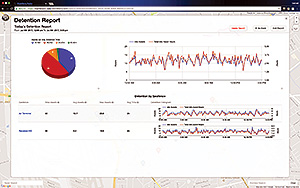
Trailer monitoring systems such as BlackBerry Radar can generate reports on detention time, which fleets can use to address delays. (BlackBerry)
“When you start introducing the ‘smart trailer’ and you can accurately predict maintenance events, you are able to eliminate real costs,” Popplewell said.
An emerging trend is to rely on the systems not just to track the trailer or cargo itself, but to increase efficiency in various workflows related to shipments, Gartner’s De Muynck said. For example, he anticipates automated inspections will help reduce the time drivers spend inspecting the inside and outside of their trailers for damage.
“We now have cheaper types of hardware and this AI machine learning, so some of those inspections are automated” through trailer and cargo sensors and cameras, he said.
Vendors continue searching for ways that trailer and cargo tracking can keep drivers happy, because “in today’s trucking environment, understanding how to improve the life of a driver is a key part of our value equation for our customers,” BlackBerry’s Plaat said.
Ultimately, the convergence of trailer intelligence and AI could enable greater efficiency across the industry.
“If the freight can be self-aware of where it’s at, what its status is, whether it’s ‘sick’ or ‘healthy,’ then it can help drive decisions all the way through the supply chain,” I.D. Systems’ Wolfe said. ³


